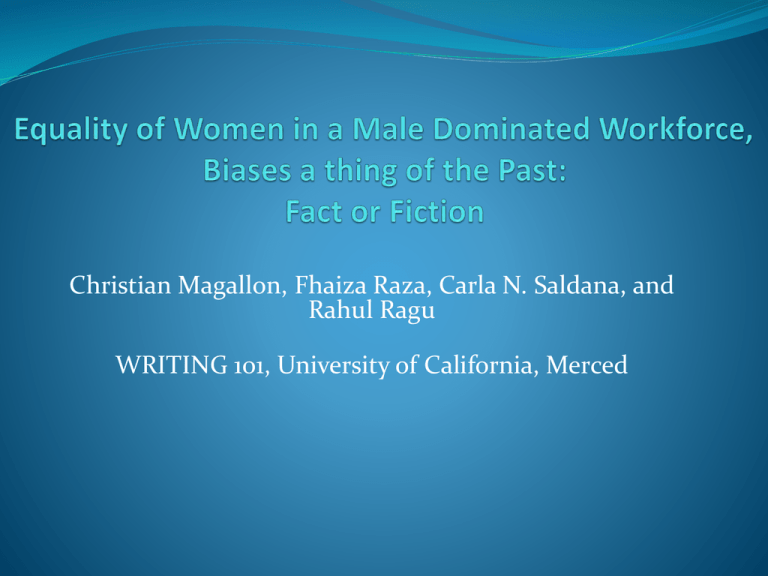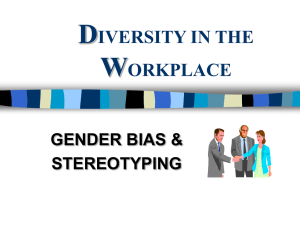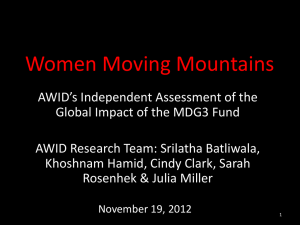
Christian Magallon, Fhaiza Raza, Carla N. Saldana, and
Rahul Ragu
WRITING 101, University of California, Merced
Introduction
Our main focus in this study is: bias in the workplace
concerning leadership, power, and perception.
By Definition:
Bias
Leadership
Power
Perception
Fact or Fiction
Men & Women are Equal?
In 2006 men held 98% of the CEO positions in large
corporations with only 2% women CEOs (Eli, 2006).
Methodology
Our research was obtained through many searches on
the University of California, Merced’s library data base.
Over 278 studies preceded using key descriptive words:
women, power, perceptions, gender bias, sexual
discrimination and leadership.
Leadership & Power
Characteristics more male oriented (Koch, Loft, and Kruse, 2005).
Men perceive appropriate characteristics to male
oriented (Brenner , Tomkiewicz and Schein, 1989).
Employers prefer masculine gender characteristics to
feminine characteristics (Goktepe & Craig, 1989).
Leadership & Power contd.
Idea of an accepted gender bias
This lack of stimuli results in a reduction in chances of
women to take on a leadership role (Carbonell & Castro, 2008).
Intimidation and feeling of doubt or inadequacy
Leadership & Power contd.
Occupational Climate (Katz, 1987).
Applied pressures
People follow trends
Perceptions
Top down (Trentham, & Larwood 1998)
Manager’s qualities (Prime, Jonsen,Carter, & Maznevski 2008)
Management ratings (Shore 1992)
Perceptions contd.
Gender role (Wolf, & Flingstein 2009)
Gender qualities (Johanson 2008)
Past/future measures (Tougas, & Beaton 1993)
Best Perceived Candidate
(Haslam
& Ryan, 2008)
Conclusion
Despite the belief that men and women are equal, statistics
and research show otherwise.
Shows that biases contribute to perceptions of leadership, and
power that keep men and women from reaching equality.
The extensive data collection through research are
FACTS not FICTION.
However, results of studies and interpretation are
subject to biases.
Limitations
Biased interpretations of results of supporting
research articles.
Biased interpretations of results of supporting
research articles.
False belief in glass ceiling hypothesis.
Women who are surveyed will give socially acceptable
answers.
Organizations may not want to be studied.
Future Studies & Implications
Studies today focus only on negative stereotypes (Hoyt &
Blalscovich, 2007).
New research should include: early intervention,
mentoring, programs to increase early exposure and
support for effected individuals
Leadership development
Improving the situation at the lower levels of
hierarchies
References
Adler, M. A. (1994). Male-Female power differences at work: A comparison of supervisor and
policymakers. Sociological Inquiry, 64(1), 37-55.
Avolio, B. J., Mhatre, K., Norman, S. M., & Lester, P. (2009). The moderating effect of gender on
leadership intervention impact: An exploratory review. Journal of Leadership & Organizational
Studies, 15(4), 325-341.
Baxter, J., & Wright, E. O. (2000). The glass ceiling hypothesis: A comparative study of the united states,
sweden, and australia. Gender & Society, 14(2), 275-294.
Bosak, J., & Sczesny, S. (2008). Am I the Right Candidate? Self-Ascribed Fit of Women and Men to a Leadership Position.
Sex Roles, 58, 682-688.
Brenner, O. C., Tomkiewicz, J., & Schein, V. E. (1989). The relationship between sex role stereotypes and
requisite management characteristics revisited. Academy of Management Journal, 32(3), 662-669.
Carbonell, J.L., Castro, Y. (2008). The impact of a leader model on high dominant women’s self-selection
for leadership. Sex Roles ,58,776-783.
Cann, A., & Siegfried, W. D. (1990). Gender stereotypes and dimensions of effective leader behavior. Sex
Roles, 23(7/8), 413-419.
EliLilly & Company. (2006). Statistics: women leaders in America. Company Confidential Copyright 2000.
Retreived from www.hrresearch.org/MBA410/Andi_Slides.ppt
Equal pay act turns 40 (2003, June 10). U.S. Equal Employment Opportunity Commission. Retrieved from
http://archive.eeoc.gov/epa/anniversary/epa-40.html
Goktepe, J.R., Craig, E.S. (1989). Role of sex, gender roles, and attraction in predicting emergent leaders.
Journal of Applied Psychology, 74(1), 165-167.
Haslam, A.S., & Ryan, M.K. (2008). The road to the glass cliff: differences in the perceived suitability of
men and women for leadership positions in succeeding and failing organizations. The Leadership
Quarterly, 19, 530-546.
Hopkins, M. M., O'Neil, D. A., Passarelli, A., & Bilimoria, D. (2008). Women's leadership development
strategic practices for women and organizations. Consulting Psychology Journal: Practice and
Research, 60(4), 348-365.
Hoyt, C.L., and Blalscovich, J. (2007). Leadership efficacy and women leaders' responses to stereotype
activation. Group processes intergroup relations,10, 595.
Jaffee, D. (1989). Gender inequality in workplace autonomy and authority. Social Science Quarterly,
70(2), 375-390.
Johanson, J.C. (2008). Perceptions of femininity in leadership: modern trend or classic component?. Sex
Roles, 58, 784-789.
Katz, D. (1987). Sex discrimination in hiring: The influence of organizational climate and need for
approval on decision making behavior. Psychology of Women Quarterly, 11(1), 11-20.
Koch, S. C., Luft, R., & Kruse, L. (2005). Women and leadership - 20 years later: A semantic connotation
study. Social Science Information, 44(1), 9-39.
Mano-Negrin, R. (2004). Gender inequality and employment policy in the public sector. Administration
and Society, 36(4), 454-477.
McTavish, D., & Miller, K. (2009). Gender balance in leadership? Reform and modernization in the UK
further education sector. Educational Management Administration & Leadership, 37(3), 350-365.
Prime,J., Jonsen, K., Carter, N., and Maznevski, M.L. (2008). Managers' perceptions of women and men
leaders: A cross cultural comparison. International Journal of Cross Cultural Management, 8, 171.
Reskin, B. F., & Ross, C. E. (1992). Jobs, authority, and earnings among managers: The continuing
significance of sex. Work and occupations, 19(4), 342-365.
Roos, P. A. (1981). Sex stratification in the workplace: Male-Female differences in economic returns to
occupation. Social Science Research, 10(3), 195-224.
Shore, T. H. (1992). Subtle gender bias in the assessment of managerial potential. Sex Roles, 27(9-10),
499-515.
Tougas, F., & Beaton, A.M. (1993). Affirmative action in the work place: for better or for worse.
International Association of Applied psychology, 42(3), 253-264.
Trentham, S., & Larwood, L. (1998). Gender discrimination and the workplace: An examination of
rational bias theory. Sex Roles, 38(1-2), 1-28.
What is AWID? (2008). The Association for Women’s Rights in Development. Retrieved from
http://www.awid.org/About-AWID/What-is-AWID.
Wolf, W. C., & Fligstein, N. D. (1979). Sex and authority in the workplace: The causes of sexual inequality.
American Sociological Review, 44, 235-252.











